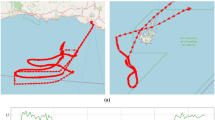Abstract
Assessing the taxonomy of fish is important to manage fish populations, regulate fisheries, and remove the exotic invasive species. Automating this process saves valuable resources of time, money, and manpower. Current methods for automatic fish monitoring rely on a human expert to design features necessary for classifying fish into a taxonomy. This paper describes a method using evolution-constructed (ECO) features to automatically find features that can be used to classify fish species. Rather than relying on human experts to build feature sets to tune their parameters, our method uses simulated evolution to construct series of transforms that convert the input signal of raw pixels of fish images into high-quality features or features that are often overlooked by humans. The effectiveness of ECO features is shown on a dataset of four fish species where using fivefold cross validation an average classification rate of 99.4 % is achieved. Although we use four fish species to prove the feasibility, this method can be easily adapted to new fauna and circumstances.






Similar content being viewed by others
References
Asian Carp Control, The official website of the Asian Carp Regional Coordinating Committee. http://asiancarp.org/background.asp
ASA (2008) Today’s angler: a statistical profile of anglers, their targeted species and expenditures. American Sportfishing Association, Alexandria
USDA, RMRS Invasive Species Research. http://www.rmrs.nau.edu/invasive_species/index.php
Zion B (2012) The use of computer vision technologies in aquaculture—a review. Comput Electron Agric 88:125–132
Alver MO, Tennoy T, Alfredsen JA, Oie G (2007) Automatic measurement of rotifer Brachionus plicatilis densities in first feeding tanks. Aquacult Eng 36(2):115–121
Zheng X, Zhang Y (2010) A fish population counting method using fuzzy artificial neural network. In: Proceedings of International Conference on Progress in Informatics and Computing (PIC), IEEE, pp 225–228
Beddow TA, Ross LG, Marchant JA (1996) Predicting salmon biomass remotely using a digital stereo-imaging technique. Aquaculture 146:189–203
Zion B, Ostrovsky V, Karplus I, Lidor G, Barki A (2012) Ornamental Fish Mass Estimation by Image Processing. Agricultural Research Organization, Bet Dagan
Karplus I, Alchanatis V, Zion B (2005) Guidance of groups of guppies (Poecilia reticulata) to allow sorting by computer vision. Aquacult Eng 32:509–520
Wallat GK, Luzuriaga DA, Balaban MO, Chapman FA (2002) Analysis of skin color development in live goldfish using a color machine vision system. N Am J Aquacult 64:79–84
Duarte S, Reig L, Oca J (2009) Measurement of sole activity by digital image analysis. Aquacult Eng 41:22–27
Rodriguez A, Bermudez M, Rabunal JR, Puertas J, Dorado J, Pena L, Balairon L (2011) Optical fish trajectory measurement in fishways through computer vision and artificial neural networks. J Comput Civ Eng 25:291–301
Zion B, Alchanatis V, Ostrovsky V, Barki A, Karplus I (2007) Real-time underwater sorting of edible fish species. Comput Electron Agric 56:34–45
Rova A, Mori G, Dill L (2007) One fish, two fish, butterfish, trumpeter: recognizing fish in underwater video. In: Proceedings of IAPR Conference on Machine Vision Applications, IAPR, pp 404–407
Lee DJ, Archibald J, Schoenberger R, Dennis A, Shiozawa D (2008) Contour matching for fish species recognition and migration monitoring. Appl Comput Intell Biol 122:183–207
Chambah M, Semani D, Renouf A, Courtellemont P, Rizzi A (2004) Underwater color constancy: enhancement of automatic live fish recognition. In: Color Imaging IX: Processing, Hardcopy, and Applications, vol. 5293. pp 157–168
Cadieux S, Michaud F, Lalonde F (2000) Intelligent system for automated fish sorting and counting. In: International Conference on Intelligent Robots and Systems, vol 2. pp 1279–1284
Li Z, Yang Y, Liu J, Zhou X, Lu H (2012) Unsupervised Feature Selection Using Nonnegative Spectral Clustering. In: Proceedings of the 26th AAAI Conference on Artificial Intelligence, AAAI, pp 1026–1032
Lillywhite K, Tippetts B, Lee DJ (2012) Self-tuned evolution-constructed features for general object recognition. Pattern Recogn 45(1):241–251
Lillywhite K, Lee DJ (2011) Automated fish taxonomy using evolution-constructed features. In: Advances in Visual Computing, ser. Lecture Notes in Computer Science. vol 6938. Springer, Berlin, pp 541–550
Roth P, Winter M (2008) Survey of appearance-based methods for object recognition. Technical report ICGTR0108 (ICG-TR-01/08), Institute for Computer Graphics and Vision, Graz University of Technology
Mitchell M (1998) An introduction to genetic algorithms. The MIT press, Cambridge
Lee DJ, Archibald JK, Schoenberger RB, Dennis AW, Shiozawa DK (2008) Contour matching for fish species recognition and migration monitoring. Applications of computational intelligence in biology: current trends and open problems. Springer, Berlin. ISBN 978-3-540-78533-0
Stanley K, Miikkulainen R (2002) Efficient reinforcement learning through evolving neural network topologies. In: Proceedings of the Genetic and Evolutionary Computation Conference. Morgan Kaufmann Publishers Inc., pp 1757–1762
Mahfoud SW (1995) Niching methods for genetic algorithms. Ph.D. dissertation, University of Illinois at Urbana-Champaign
Potter M, De Jong K (1995) Evolving neural networks with collaborative species. In: Summer Computer Simulation Conference, Society for computer simulation, pp 340–345
Author information
Authors and Affiliations
Corresponding author
Rights and permissions
About this article
Cite this article
Zhang, D., Lillywhite, K.D., Lee, DJ. et al. Automatic fish taxonomy using evolution-constructed features for invasive species removal. Pattern Anal Applic 18, 451–459 (2015). https://doi.org/10.1007/s10044-014-0426-2
Received:
Accepted:
Published:
Issue Date:
DOI: https://doi.org/10.1007/s10044-014-0426-2




